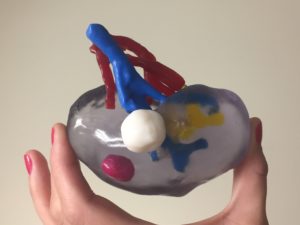Augmented Reality Versus 3-D Printing for Radiology
 Three-dimensional (3-D) printing and augmented reality (AR) are two of the more exciting technologies being explored in radiology today. In their own way, each technology gives form and depth to medical imaging data, offering a new perspective for physicians and patients. Early explorations have promised new ways to plan surgical and interventional procedures, and new methods to help patients understand what care is being delivered and how. For now, however, both technologies are still largely viewed as novel, with at best anecdotal evidence of how they can be translated into clinical use. A pair of recent large-scale studies may offer a sense of how to collect quantitative evidence that these technologies can benefit all members of the healthcare team.
Three-dimensional (3-D) printing and augmented reality (AR) are two of the more exciting technologies being explored in radiology today. In their own way, each technology gives form and depth to medical imaging data, offering a new perspective for physicians and patients. Early explorations have promised new ways to plan surgical and interventional procedures, and new methods to help patients understand what care is being delivered and how. For now, however, both technologies are still largely viewed as novel, with at best anecdotal evidence of how they can be translated into clinical use. A pair of recent large-scale studies may offer a sense of how to collect quantitative evidence that these technologies can benefit all members of the healthcare team.
When the HoloLens was first released, Wake was already working in 3-D printing but recognized the limitations of the technology — primarily the amount of time required to create a 3-D printed model.
Data indicated that the 3-D models resulted in a change to the type of procedure planned as much as 50 percent of the time.
Models for the second group were either 3-D printed, visualized in AR, or viewed in 3-D on a 2-D monitor. To measure patient response, Wake and colleagues used a five-point Likert scale survey — on a scale of 1 to 5, patients rated their understanding of:
• Their cancer/disease itself;
• The size of the tumor/cancer;
• The location of the tumor/cancer;
• Why the surgeon chose their given treatment plan; and
• Their comfort with the surgical plan.
“Just seeing the anatomy in 3-D, whether a virtual model or a physical tactile model, is much more powerful than simply viewing grayscale medical images on a 2-D screen, especially for patients who might not have seen a medical image before so they don’t really know what they’re looking at,” Wake said.
Despite the utility of both technologies, cost remains a prohibitive factor blocking widespread adoption. Wake said a planned future prospective study will provide a deeper cost analysis in hopes of expanding the utility of 3-D printing and AR.
See the full story here: https://www.itnonline.com/article/augmented-reality-versus-3-d-printing-radiology
Pages
- About Philip Lelyveld
- Mark and Addie Lelyveld Biographies
- Presentations and articles
- Tufts Alumni Bio